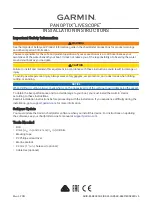
16
4.4.
AUTOPILOT SETTINGS
4.4.1.
Autopilot gain
The pilot gain allows the boat to be more responsive. Gain increase is often used in the
following circumstances:
•
In rough sea conditions, the increase of the gain allows to counter more efficiently the
strong waves which cause lurches.
•
When sailing downwind, with powerful sails such as a spinnaker, the increase in gain
helps to avoid excessive set-up variations which can cause into the wind or down the
wind runs.
The setting range is between 1 and 9.
4.4.2.
Rudder coefficient
The rudder coefficient controls the amplitude and acceleration of the rudder movements
according to the speed of the boat. Its value is increased in proportion to the speed of the
boat.
The setting range is between 1 and 53.
4.4.3.
The counter rudder
The counter rudder prevents trajectory fluctuations from occurring around the set point. The
boat's motion expectation is preset. Anticipation is necessary in the following cases:
•
Boats with high inertia. Naturally, the counter-rudder value will be high
•
The delay of pilot data is sometimes intentional for filtering reasons
•
Trajectory fluctuations around the set point
The setting range is between 1 and 9.
4.4.4.
Wind smoothing
Wind smoothing is used in apparent wind, true wind or polar mode. This setting is used to
stabilise the steering when the wind measurement fluctuates. The setting range is between 1
and 9.
4.4.5.
Tacking angle
This is the auto-tacking angle in compass mode, adjustable from 70 to 115° with increments
of 5°.








































